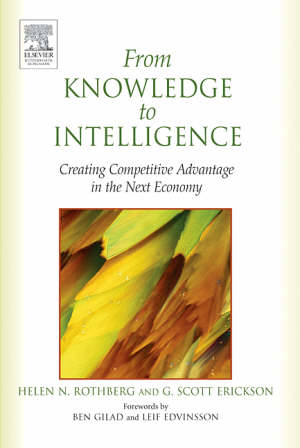Part One: Knowledge Meets Intelligence Chapter 1: Generating Competitive Capital. The intersection of the fields of knowledge management and competitive intelligence, including the similarities of the two fields. Competitive knowledge is a knowledge asset, and both disciplines have something to offer one another.Chapter 2: Turning Knowledge Into Active Intelligence. How applying intelligence techniques to knowledge can enhance the field through a wider definition of knowledge, purposeful search inside and out, analysis, and delivery to top decision-makers. Also, recognize the threat of competitive intelligence to your knowledge assets.Chapter 3: It’s a Risky Business. Defining the risks of knowledge management growth (not doing enough) and competitive intelligence (not protecting what you have). Since these move in opposite directions as knowledge assets grow, the risks must be balanced. Determining your balance (Strategic Protection Factor) is dependent on circumstances, and four different scenarios are presented.Part Two: Strategy for Shifting Knowledge to IntelligenceChapter 4: Determining an SPF: National Considerations. National factors, in areas such as government, infrastructure, and economic culture, determining your risk levels and SPF.Chapter 5: Determining an SPF: Industry Considerations. Industry factors, in areas such as importance of knowledge in your industry, Value Chain coordination, and competitive arena, determining your risk levels and SPF.Chapter 6: Determining an SPF: Organizational Considerations. Firm factors, in areas such as resources, execution, competitors, and network considerations, determining your risk level and SPF.Part Three: Knowledge to Intelligence Across the EnterpriseChapter 7: Intelligence Across the Enterprise. E-business is alive and well, and it affects intelligence. Operational information from e-business systems such as ERP, SCM, and CRM are assets, can become valuable knowledge or intelligence, and are of interest to your competitors. And the close relationships engendered by such systems can result in sharing of other knowledge assets, too.Chapter 8: Intelligence Across the Value Chain: Upstream. Examples of upstream knowledge sharing, with suppliers, R&D partners, logistics providers, and others. Also includes protection considerations.Chapter 9: Intelligence Across the Value Chain: Downstream. Examples of downstream knowledge sharing, with distribution partners, retailers, marketing communication agencies, and others. Also includes protection considerations.Part Four: A Blueprint for Shifting from Knowledge to IntelligenceChapter 10: Installing the Intelligence Program: Structure. The basics of an intelligence structure, including cross-function, boundary-spanning intelligence teams, expert rings, and intelligence facilitators with top-level access, and network issues. The basics of a counterintelligence structure, designed to protect the firm from competitive incursions seeking knowledge.Chapter 11: Installing the Intelligence Program: Culture. Softer issues of initiating and maintaining an intelligence program, including leadership, a fearless space, trust, and network issues.Chapter 12: Ethics of Intelligence: Keeping Your Hands Clean, by Joanne Gavin. Legal and ethical issues of an intelligence approach, particularly concerning gathering and using competitive knowledge.











